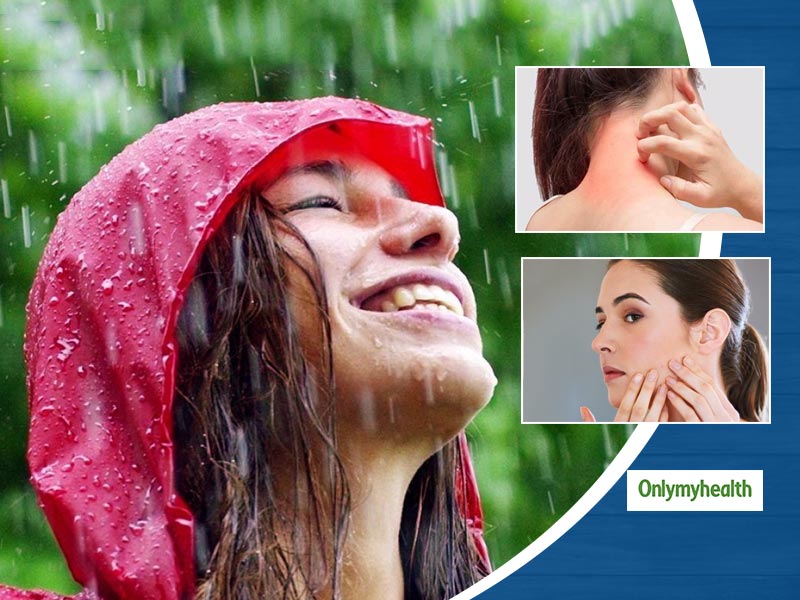
Skin problems in monsoon: Even though the monsoon season provides the much-needed relief from the scorching summer heat, it could still pose a threat to your health. Owing to excessive rainfall, increased humidity, and water stagnation, we are at risk of various skin infections and other diseases. Have you heard about folliculitis? It generally occurs in arms, upper back, scalp and thighs area and can be painful and infected with pus. Below are some of the well-known skin problems in monsoons:
- ACNE: Rash and acne is something most of us face often! Moreover, it depends on your skin type, and the sort of care that you need to take during the monsoon will vary. Excessive oil secretion from the skin can lead to pimples. Hence, use natural oil-free soaps/face wash.
- EXCESSIVE SWEATING: We all know that due to the increased dampness, during the monsoons, (the humidity in the air is higher), and there can be excessive sweating in this season. It is recommended to avoid using excessive moisturisers and lotions. The kind of food one eats during this season also has an impact on the skin and body. So avoid overeating of fried and oily food.
- ECZEMA: Do you know that the skin-related disease is more likely to occur during the rainy season? This causes itching, rashes and redness on the skin. In many cases, it also irritates. People with sensitive skin have a higher chance of having this infection.
- DRY SKIN: People with dry skin face the issue of rashes, flaking, and itchiness. Do you know the best solution to ensure to keep these problems at bay? You have to apply a good moisturiser daily. Refrain from using string astringent lotions that have chemicals as these can increase dryness of skin and cause rash.
Also Read: DIY Sunflower Seeds Mask For Skin Rejuvenation and Glow
- ITCH: Itch or scabies is an infectious disease. The penetration of the mite causes this infection into the skin. The parasite forms a nest in the skin and lays eggs in it, thereby increasing the disease. Eating occurs, causing hole-forming, skin itching, lumping problems.
- TINEA FUNGAL INFECTIONS: These include highly communicable skin and itchy issues like ringworm (skin infection in body folds like thighs, armpits, etc.); flaky or itchy scalp (tinea capitis) and fungal infection in the nails (onychomycosis), causing them to become brittle and fragile.
Also Read: Are You Exfoliating Your Skin More Than What’s Required? Know Signs of Over-Exfoliated Skin
- FOLLICULITIS: A bacterial or fungal infection of the hair follicle. What is the role of hair follicle? Hair follicles are meant to protect us, and therefore our entire body is covered with them. The contact between sweat and fungus or bacteria results in skin problem, which can cause folliculitis.
- RINGWORM: Usually identified by red ring-shaped infection on the skin, hence named as ringworm. If scratched, it sometimes can be accompanied by minute eruptions on the skin and, can lead to oozing. It is a very contagious fungal infection which at times even spreads to the scalp.
- SCABIES: A monsoon skin disease caused by tiny microscopic bugs. Do you know that these insects float on the skin for months? They burrow in the cuticle to lay eggs which cause immense uncontrollable itching, which causes redness. It is a highly dangerous infection and can spread through close contacts with the patient.
- NAIL INFECTIONS and ATHLETES FOOT: Closed shoes and rainwater can be a breeding ground for infection. This infection causes nail discolouration, brittleness, and swollen nail beds. An athlete’s foot, the skin becomes red, itchy, cracked along with burning sensation.
(Medically reviewed by Dr DM Mahajan, Senior Consultant, Dermatology, Indraprastha Apollo Hospitals)
Read More Articles in Skin Care
How we keep this article up to date:
We work with experts and keep a close eye on the latest in health and wellness. Whenever there is a new research or helpful information, we update our articles with accurate and useful advice.
Current Version
